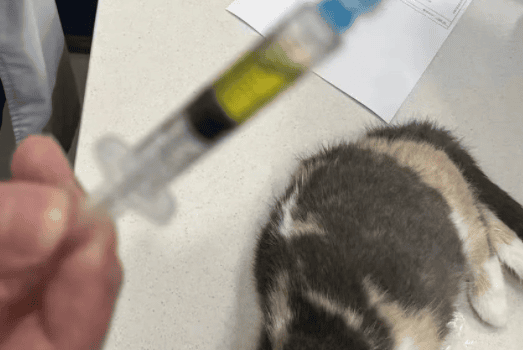Detection method of FCoV transmitted from cats to abdominal FIP
Blood:
Nucleic acid detection technology RT-PCR (including real-time RT-PCR and RT-nPCR). The sensitivity is 9~77%, the specificity is 88~100%, and it is not specific to FIP; FCoV viremia can also be detected in cats with RT-PCR feline abdominal virus, and the viral load is usually found in cats with FIP virus. Quantity is very low.
Real-time RT-PCR of the M gene has a sensitivity of 46~100% and a specificity of 48~100%. It is not unique to FIP; FCoV mRNA can also be detected in cats without FIP.
S gene RT-PCR has a sensitivity of 0~23% and a specificity of 95%, and may give false positive results; in cats with FIP disease, the viral load is usually very low.
Sequencing of S gene mutations has a sensitivity of 7~43% and no data on specificity. It is more useful than S gene RT-PCR. It is controversial whether the S gene mutation is unique to FIP or just FCoV. A sign of systemic spread.
Antibody detection, including ELISA, has a sensitivity of 28~85% and a specificity of 25~92%. It is not specific to FIP; anti-FCoV antibodies can also be detected in cats without FIP.

Exudate:
Detection of FCoV antigen by IFA or ICC, sensitivity 57~100%, specificity 71~100%, if combined with a positive conventional diagnostic test consistent with that - FIP is likely not, and cats with FIP may have false positive results.
RT-PCR (including real-time RT-PCR and RT-nPCR), sensitivity 72~100%, specificity 83~100%, not specific to FIP; can also be detected in cats without FIP to FCoV RNA.
S gene RT-PCR has a sensitivity of 64~69% and a specificity of 86~96%, which is more useful than S gene RT-PCR. It is controversial whether S gene mutations are specific to FIP or only as an FCoV system. Signs of sexual transmission.
Antibody detection, with a sensitivity of 86% and a specificity of 85%, is not specific to FIP; anti-FCoV antibodies can also be detected in cats without FIP.
Cerebrospinal fluid:
ICC detects FCoV antigen with sensitivity 78~91% and specificity 50~88%, if combined with a positive result from consistent conventional diagnostic tests – FIP probable, no False-positive results may occur in cats with FIP. RT-PCR (including real-time RT-PCR and RT-nPCR)
RT-PCR (including real-time RT-PCR and RT-nPCR), sensitivity 17~86%, specificity 100%, not specific in FIP; FCoV RNA can also be detected in cats without FIP. Cats with neurological symptoms are more sensitive than cats without neurological symptoms.
S gene RT-PCR has a sensitivity of 8~44% and a specificity of 95%. It can give false positive results; it is not helpful to confirm the diagnosis of FIP.
Antibody detection, sensitivity 0~94%, specificity 93~100%, not specific to FIP; anti-FCoV antibodies can also be detected in cats without FIP, and cats with neurological symptoms are better than cats without neurological symptoms. Cats with systemic symptoms are more sensitive.

Aqueous humor:
ICC detects FCoV antigen with a sensitivity of 64% and a specificity of 82%, and if combined with a positive conventional diagnostic test consistent with FIP – FIP is very likely, false positive results may occur in cats without FIP.
RT-PCR (including real-time RT-PCR and RT-nPCR), sensitivity 25~50%, specificity 100%, not specific to FIP; FCoV can also be detected in cats without FIP RNA.
S gene RT-PCR, with a sensitivity of 10~13% and a sensitivity of 100%, can give false positive results; it is not helpful to confirm the diagnosis of FIP.
Organization: < /p>
Detect FCoV antigen through IHC, with a sensitivity of 98% and a specificity of 100%, which is the gold standard for FIP diagnosis.
ICC detects FCoV antigen in FNA specimens, sensitivity: 17~31% (liver), 11~20% (kidney), 53% (mesenteric lymph node), specificity 91% (mesenteric lymph node) , if combined with a positive conventional diagnostic test that is consistent with FIP – FIP is very likely, a false positive result may occur in cats without FIP.
RT-PCR (including real-time RT-PCR and RT-n PCR; FNA or biopsy specimen), sensitivity 65~100%, specificity 50~96%, not specific to FIP; in the absence of FIP FCoV RNA can also be detected in cats. Susceptibility depends on organ involvement.
S gene RT-PCR has a sensitivity of 15~71% and 67~100%, and can give false positive results; it is not helpful to confirm the diagnosis of FIP.
S gene mutation sequencing has a sensitivity of 70~89% and a specificity of 88~100%, which is more useful than S gene RT-PCR. It is controversial whether S gene mutations are specific to FIP or only systemic to FCoV. Communication sign.

 扫一扫微信交流
扫一扫微信交流
发布评论